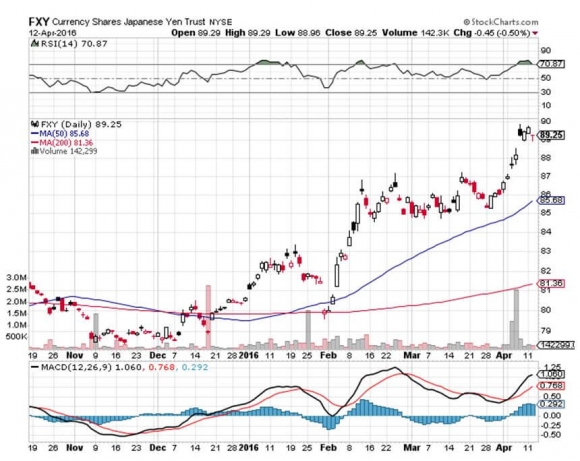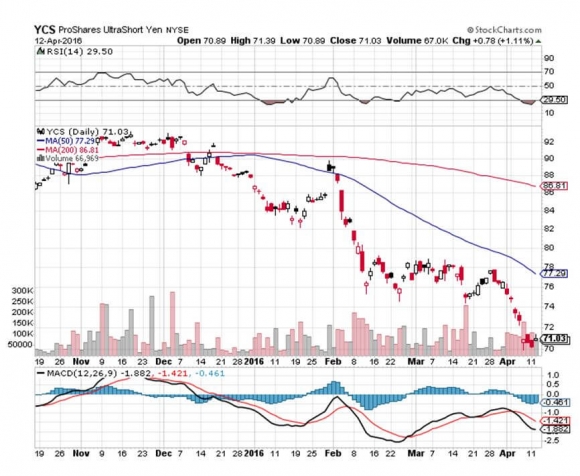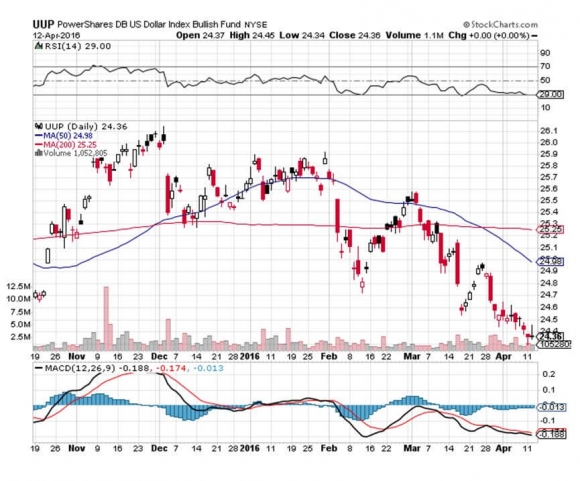In short, nobody knows.
I have talked to about every currency guru out there and all seem as puzzled, perplexed, befuddled, and confused as I am.
Not only that, there hasn?t been any confirmation of the strong yen from other asset classes, which has rocketed from a low of ?125.85 last June to a high of ?107.60 this week.
Normally when the yen is strong, you expect stocks (SPY), (IWM), junk bonds (HYG), and emerging markets (EEM) to be in free fall. They aren?t. In fact all of these high beta asset classes are pushing up against one-year highs.
Either the virile yen is presaging a gut wrenching crash in stock prices, or it isn?t. Go figure.
However, I do have a few theories.
1) The strong yen is part of a generalized weak dollar move (UUP) triggered by the cancellation of the next seven Federal Reserve interest rate hikes brought on by the January stock crash. The Chinese stock crash poured gasoline of the flames.
Over the long term, interest rate differentials explain all foreign currency moves, and the greenback just gave up its advantage.
2) A lot of hedge funds ended 2015 with large short positions in the yen, making them ripe for a short squeeze.
In fact, the net trader?s position swung from a short of 30,300 futures contracts in December to long 50,000 contracts in January. This is a humongous swing of $9 billion in underlying.
Since then, there was been a continuing cycle of traders reestablishing shorts based on poor Japanese fundamentals, then getting stopped out, and repeating the cycle again and again, taking the yen ever higher, and the P&L?s of traders ever lower.
3) April is the beginning of the Japanese fiscal year, and the yen is always strong as Japanese repatriate foreign profits to invest in Japan and avoid local taxes.
4) Despite this massive move in the yen against the long-term economic interests of Japan, the Bank of Japan has not lifted a finger to stop it with more quantitative easing. Negative interest rates only made the yen stronger. As central bank meetings came and went with no effective action, new yen buying waves were triggered.
You really have to ask the question of ?How stupid can a government get before they do the right thing?? The answer, to the pain of many forex traders is ?A lot more stupid than you think.?
5) The truly amazing thing is that the strong yen continued in the face of a massive capital flight from Japan fleeing the country?s new negative interest rate policy.
According to Japan?s Ministry of Finance, some $3.2 billion left Japan for sunnier climes and higher interest rates in January, followed by $27 billion in February and a staggering $53 billion in March. This enormous outflow will continue for the rest of this year. Notice the hyperbolic increase.
6) Even more amazing is that the yen has continued to appreciate in the face of huge sales of Japanese stocks by foreign investors in Q1, some $63 billion. They are seeking to duck the hit Japanese corporate earnings will take from the strong yen. Some 10% of the total Japanese foreign earnings have vaporized in just three months.
All of this is proof that this is not your father?s trading markets. All asset classes are trading totally differently than they have in the past.
The last time I experienced conditions like this it was in Japan in the early 1990?s, right at the onset of a 20-year financial and economic crash.
Real individual and institutional end investors had totally abandoned the market. All that were left we an odd assortment of hedge funds, bank proprietary books, and spivs.
After the initial six month, 50% crash in the Nikkei Average, nobody made any money. Traders were just batting the same stock back and forth like in a ping-pong match, with little net overall movement.
In other words, it was a trader?s worst nightmare. No one earned even enough to cover their nighttime sushi and Suntory Whiskey bills. And this went on for two decades.
Today, I have a grand total of five subscribers in my former home of Japan. I have over 100 in Singapore catering to the enormous offshore Chinese business.
I don?t think this is happening right now in the US. Still, the similarity is unnerving.
So what happens next?
As we approach the second half of 2016, the prospects for a new round of Fed rate raises will return. When that happens, it is back to the penalty box for the yen as its dire fundamentals reassert themselves once more.
I expect it to quickly give up all of its gains for this year and maybe more. One can only hope.
That?s when you plow back into long positions in the (YCS) and short positions in the (FXY).







